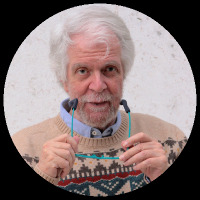Papers by Ferhat Bejtullahu
Towards Regenerative Buildings in Kosovo
BIM role in enabling sustainability and better asset performance over the life-cycle (comparative context)
Life-Cycle of Engineering Systems, 2016

"Identifying required social changes to avoid gaps in the development of a regenerative built environment, 2022
The paper argues the need for changes in the social aspect as the main factor in developing a reg... more The paper argues the need for changes in the social aspect as the main factor in developing a regenerative built environment. The social aspect is overlooked in discussing all scales and dimensions of a regenerative environment. This paper focuses on systems thinking for social change at the local and global levels that will have an impact on creating a regenerative built environment (RBE). Although climate crises occur due to both internal and external factors people need to think and act locally and globally to reduce the negative impact of internal factors. The assumption about overlooked social aspects and hypotheses about social changes that will change architecture to an example of the de-carbonization of our economy are confirmed thru the literature review. Rapid changes and paradigm shift towards new concepts will impact social and environmental changes toward regenerative architecture solutions. Social changes impacted by new clean technologies serve as answers to the question of which rapid changes are required in process of de-carbonization.

"Identifying required social changes to avoid gaps in the development of a regenerative built environment, 2022
The paper argues the need for changes in the social aspect as the main factor in developing a reg... more The paper argues the need for changes in the social aspect as the main factor in developing a regenerative built environment. The social aspect is overlooked in discussing all scales and dimensions of a regenerative environment. This paper focuses on systems thinking for social change at the local and global levels that will have an impact on creating a regenerative built environment (RBE). Although climate crises occur due to both internal and external factors people need to think and act locally and globally to reduce the negative impact of internal factors. The assumption about overlooked social aspects and hypotheses about social changes that will change architecture to an example of the de-carbonization of our economy are confirmed thru the literature review. Rapid changes and paradigm shift towards new concepts will impact social and environmental changes toward regenerative architecture solutions. Social changes impacted by new clean technologies serve as answers to the question of which rapid changes are required in process of de-carbonization.
As of 2008, for the first time in human history, half of the world's population now live in citie... more As of 2008, for the first time in human history, half of the world's population now live in cities. And with concerns about issues such as climate change, energy supply and environmental health receiving increasing political attention, interest in the sustainable development of our future cities has grown dramatically. Yet despite a wealth of literature on green architecture, evidence-based design and sustainable planning, only a fraction of the current literature successfully integrates the necessary theory and practice from across the full range of relevant disciplines.

2013 UBT International Conference, 2013
The building sector is responsible for a substantial part of energy use in Europe and Kosovo. Bui... more The building sector is responsible for a substantial part of energy use in Europe and Kosovo. Buildings in Kosovo account for 40 % of the total energy demand, but the building sector pays little or no attention to energy efficiency. The most relevant laws (Energy Efficiency law is in force since July 2011), administrative instructions, regulations and strategic documents in field of energy efficiency are almost completed but implementation and enforcement is still very weak. Despite all this laws, new regulations and other measures that regulates technical requirements for thermal energy saving and thermal protection, application and management faces difficulties especially in planning and implementing energy efficiency in new buildings according to "ENERGY PERFORMANCE OF BUILDINGS DIRECTIVE 2010/31/EU" The paper will identify barriers and recommend appropriate methods and tools for improving energy efficiency in buildings through implementation of initiatives as efficiency labeling or certification that will raise buildings energy efficiency (EE) beyond minimum requirement and social, spatial and environmental measures for improving EE in buildings. The study concludes that most important factor for EE in buildings is reduction in energy demand in existing and new designed buildings. Best solution to achieve thesis creating a Building Model for Energy Evaluation
Architecture in Post War City – State (Republic of Kosova)
2018 UBT International Conference, 2018

JOURNAL OF INTERNATIONAL BUSINESS RESEARCH AND MARKETING, 2017
Extreme weather events are increasing in intensity and frequency. While the social component of r... more Extreme weather events are increasing in intensity and frequency. While the social component of resilience with all its dimensions depend on all citizens, spatial and environmental components with all their dimensions depend on more from architects than from other professionals. In this context, architects have a responsibility to evaluate, design (create) and maintain resilient build environment that can better adapt to natural conditions and that can more readily absorb and recover city from different disasters. The objective of this research is to identify the role of architects in creating the building as well as the quality of urban resilience that can be implemented in a variety of contexts at national, regional or global level. Conclusions serve as a new concept to future researchers in this field and to all regional stakeholders engaged in the process of evaluating the risk related to the natural disaster. Also, it creates professional strategies for improvement of building ...

2014 UBT International Conference, Nov 8, 2014
Building physics and climate adapted architectural design parameters such as site, building form,... more Building physics and climate adapted architectural design parameters such as site, building form, orientation, shading and envelope performance (including structures and openings), contributes a significant proportion towards the better energy performance and reduce environmental impact of buildings. Due to extensive demand of electricity derived from the widespread use of cooling and heating systems has necessitated evolution and incorporation of minimum energy performance requirements in design practice. Objective of this paper is to promote role of passive design features and energy simulation to the researchers, scientists and practitioners within planning, architecture construction industry. Jointly, all these three industries are experiencing an continues shift whereby the issues of sustainable environment, resource conservation and energy efficiency have gained vital importance. Findings from this research require cultural assimilation into planning and architecture (including curriculums), construction industry and building-owner decision making in Kosovo. In order to achieve strategies and implement new concept, it is important to address these issues with a sense of urgency.
Avoiding and reflecting on disasters with resilience and regenerative design
Use of Building Information Modeling (BIM) for Heritage Buildings in Kosovo

Cities in region haze experienced social disturbances. War, crime and corruption divert resources... more Cities in region haze experienced social disturbances. War, crime and corruption divert resources from areas of greatest human need; damage the capacity of societies to plan for the future, and generally threat human well-being and the environmental sustainability. Sustainability is studied and managed over many scales of time and space and in many contexts of environmental, social and economic organization. The focus of this study is on Environmental Sustainability of Cities in region thru impact of collective residential buildings in neighborhoods, occupations, lifestyles, behavior patterns and so on. Best international approaches and principles will be analyzed and compared with regional trends. Many approaches, lightly constructed around new urbanism, are effectively reducing environmental impacts by changing the built environment to create and preserve sustainable cities which support sustainable transport. Residents in compact urban neighborhoods drive less, and have significa...

1 ABSTRACT The aim of the paper work is to provide a research that forms the basis for the Sustai... more 1 ABSTRACT The aim of the paper work is to provide a research that forms the basis for the Sustainable Environmental Management in general, its appliances within overall progress cities, with intention to encourage responsible authorities to provide comprehensive guidelines and manage environmental consequences due to misapplied regulations of the sustainability assessment of new construction in Kosovo. Many new building programmes require one of most common used models of sustainability. Regardless the sustainability assessment of buildings, comparable alternatives of buildings assessment management methods and in default of appropriate Green Construction Rating System (GCRS) as the benchmark for measuring the sustainability of new building structures, the paper work in general focus attempt for appliances of GCRC – assessment of buildings and solutions for management methods that can be successfully implemented in local level and/or regional level, in this case Pristina City.

The paper contents qualitative research that covers the scope of Resilience, Green Building, and ... more The paper contents qualitative research that covers the scope of Resilience, Green Building, and BIM (Building Information Modeling) concepts implementation. The objective of the paper is to facilitate the discussion on the question how these concepts can be integrated to apply in architecture theory and practice by making science-based building decisions that will improve the overall performance of construction projects. Research is done in global and regional context focused in the Republic of Kosovo. The specific objective of this paper is to facilitate socially innovative actions and initiatives as a primary source for integration of resilience, green building and BIM technology in the daily life. Participating and observing group discussions with architects, spatial planners, and environmental professionals helped to uncover trends in theory and practice, and dive deeper into the problem. State of art literature review on this topic and personal interviews in daily work helped ...

Urban environmental degradation and disasters are leading to a paradigm shift towards implementin... more Urban environmental degradation and disasters are leading to a paradigm shift towards implementing regenerative and resilient concepts on all scales. The interrelationship between microscopic and macroscopic elements of the built environment must be considered from pre-design through to building handover to avoid future disasters and environmental degradation in urban areas. This paper aims to identify synergies between the resilient and regenerative design activities needed on all scales and dimensions. The developed conceptual framework represents the context in which the study is conducted. Cooperation strategies on different scales are required to mitigate the climate crisis by reflecting the dimension of increasing energy consumption requirements from materials to the urban built environment in cities. The methods used to answer the research questions are data analysis from literature and trend comparisons at local, regional and global levels. New approaches and interrelationsh...

Prishtina has different zones ranging from rural suburb and informal settlements to dense skyscra... more Prishtina has different zones ranging from rural suburb and informal settlements to dense skyscrapers and high standard housing. The environmental quality of the old urban form in the inner city has been changed by new controversial pieces of urban architecture. Effects of a globalized but individualized lifestyle society in new urban centers and redeveloped abandoned sites have become the heterotopia 1 . As a key factor in the category of sustainable architecture, the evaluation of the housing quality has moved on to the diversity of housing schemes and promoted the quality of urban living. The purpose of this research is to identify design and planning principles that will use new social demand of Housing Quality and Urban Livability (HQUL) for city identity creation thru sustainable architecture in Prishtina. Controversial pieces of urban architecture in Prishtina are a reflection of many uncertainties that a design project, a building, an urban plan, or a construction process un...
Creating user-friendly public spaces in Cities (Prishtina), between public interest and private r... more Creating user-friendly public spaces in Cities (Prishtina), between public interest and private rights Ferhat Bejtullahu

2015 UBT International Conference, Nov 7, 2015
Architects are highly dependent from technology and the need to have integrated tools that also a... more Architects are highly dependent from technology and the need to have integrated tools that also allows them to create models. The main objective of this research is to identify architects role in change influenced by technology and increasing urban data (BIM , GIS and CODES). Architects role in given context is analyzed from global and local perspective. Specific objective of this research is to investigate the use of BIM and urban data from perspective an architect, analyze reduced architects' influence, owners crush design fees and possibilities to take back design control. Literature review, daily spontaneous interviews with participants in the planning and design phase of Prishtina projects and three interviews with experts in information technology have been conducted. Understanding role in change influenced by technology and increasing urban data would minimize misunderstandings and provide architects and each participant in construction industry with clear responsibilities.

2017 UBT International Conference, Oct 27, 2017
The paper contents qualitative research that covers the scope of Resilience, Green Building, and ... more The paper contents qualitative research that covers the scope of Resilience, Green Building, and BIM (Building Information Modeling) concepts implementation. The objective of the paper is to facilitate the discussion on the question how these concepts can be integrated to apply in architecture theory and practice by making science-based building decisions that will improve the overall performance of construction projects. Research is done in global and regional context focused in the Republic of Kosovo. The specific objective of this paper is to facilitate socially innovative actions and initiatives as a primary source for integration of resilience, green building and BIM technology in the daily life. Participating and observing group discussions with architects, spatial planners, and environmental professionals helped to uncover trends in theory and practice, and dive deeper into the problem. State of art literature review on this topic and personal interviews in daily work helped to analyze and compare the local, regional and international implementation of concepts. Results of the research paper will help to understand of the global and regional architects and planning professionals in order for there to be clear the need for promoting the notion of BIM, resilience and green building and integrating them in theory and practice. In conclusions will be described conditions for integrating new concepts interconnected in new inclusive strategies. Integration will narrow the gap between the EU and Balkan countries. In recommendations will be proposed framework that can potentially enhance community decisions by creating an opportunity to achieve synergy among different interconnected multispectral stakeholders in the building sector.

Urban environmental degradation and disasters are leading to a paradigm shift towards implementin... more Urban environmental degradation and disasters are leading to a paradigm shift towards implementing regenerative and resilient concepts on all scales. The interrelationship between microscopic and macroscopic elements of the built environment must be considered from pre-design through to building handover to avoid future disasters and environmental degradation in urban areas. This paper aims to identify synergies between the resilient and regenerative design activities needed on all scales and dimensions. The developed conceptual framework represents the context in which the study is conducted. Cooperation strategies on different scales are required to mitigate the climate crisis by reflecting the dimension of increasing energy consumption requirements from materials to the urban built environment in cities. The methods used to answer the research questions are data analysis from literature and trend comparisons at local, regional and global levels. New approaches and interrelationsh...











Uploads
Papers by Ferhat Bejtullahu
The specific objective of these paper is to suggest principles and policies in relation to identified challenges of architecture in local context compared to regional and global trends in architecture.
Different methods are used to analyze and compare Prishtina as a post-war city in the context of architectural values. Missing all aspects of city sustainability are described for identification and a better understanding of architectural challenges in local context. The identification process was implemented through the study of official documents, strategies, interviews, and discussions about possibilities for integration of architectural values in the planning process and city life.
Conclusions will describe measures and actions needed to overcome challenges and produce increased architectural values as a synergy of collaboration between client and architect. Recommendations will focus on the promotion of awareness, production, and examples.
Keywords: Architectural challenges, values, city life